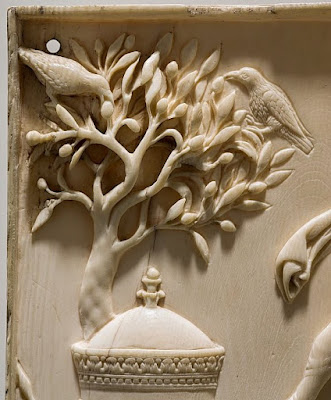I've seen it before, but just reencountered it in John Dominic Crossan and Sarah Sexton Crossan's Resurrecting Easter: How the West Lost and the East Kept the Original Easter Vision, part of my Lenten reading. The Crossans' story is that it took Christian iconography a long time to find ways of representing the resurrection, which, after all, isn't directly described in any of the canonical gospels. (The Gospel of Peter obliges.) The Reidersche Tafel is shown as they work their way from symbolic depictions through a series of images in which Jesus awakens, steps out of and finally hovers above the tomb. But that happens centuries later than this carving, which leads to a detour on how the discovery of the tomb and the erection of a church above it (perhaps shown here) ushered in a period where representing the tomb took the place of the event. But this isn't just the tomb yet.
This is again a symbolic depiction of the actual moment of resurrection. Here the solution is the olive tree growing luxuriantly out of the very top of the tomb with birds feeding on its fruit ... This is the resurrection as the Tree of Life for the world; and this olive tree visually links the Resurrection, on the left, to the Ascension on the Mount of Olives, on the right (Acts 1:12). ([HarperOne, 2018], 49)
It is an exquisite tree, a marvel of art and technique. But is it really also a representation of the resurrection? That would be grand! The other accounts of the iconography of the tree I've found (on a rather cursory search) present it as representing the church, the two birds its Jewish and Gentile members. And the Tree of Life isn't usually depicted as an olive. But this carved wonder is definitely doing more than just filling out the space as beardless Jesus gets a hand on his way into the sky, and clearly growing out of the tomb. Fascinating!

